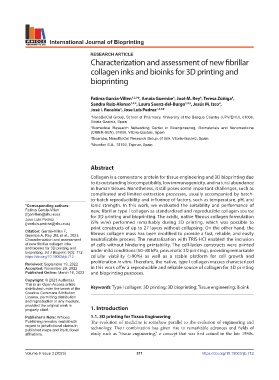Page 319 - IJB-9-3
P. 319
International Journal of Bioprinting
RESEARCH ARTICLE
Characterization and assessment of new fibrillar
collagen inks and bioinks for 3D printing and
bioprinting
Fatima Garcia-Villen 1,2,3 *, Amaia Guembe , José M. Rey , Teresa Zúñiga ,
4
4
4
Sandra Ruiz-Alonso 1,2,3 , Laura Saenz-del-Burgo 1,2,3 , Jesús M. Izco ,
4
José I. Recalde , Jose Luis Pedraz 1,2,3 *
4
1 NanoBioCel Group, School of Pharmacy, University of the Basque Country (UPV/EHU), 01006,
Vitoria-Gasteiz, Spain
2 Biomedical Research Networking Center in Bioengineering, Biomaterials and Nanomedicine
(CIBER-BBN), 01006, Vitoria-Gasteiz, Spain
3
Bioaraba, NanoBioCel Research Group, 01009, Vitoria-Gasteiz, Spain
4 Viscofan S.A., 31192, Tajonar, Spain
Abstract
Collagen is a cornerstone protein for tissue engineering and 3D bioprinting due
to its outstanding biocompatibility, low immunogenicity, and natural abundance
in human tissues. Nonetheless, it still poses some important challenges, such as
complicated and limited extraction processes, usually accompanied by batch-
to-batch reproducibility and influence of factors, such as temperature, pH, and
*Corresponding authors: ionic strength. In this work, we evaluated the suitability and performance of
Fatima Garcia-Villen new, fibrillar type I collagen as standardized and reproducible collagen source
(fgarvillen@ehu.eus) for 3D printing and bioprinting. The acidic, native fibrous collagen formulation
Jose Luis Pedraz
(joseluis.pedraz@ehu.eus) (5% w/w) performed remarkably during 3D printing, which was possible to
print constructs of up to 27 layers without collapsing. On the other hand, the
Citation: Garcia-Villen F,
Guembe A, Rey JM, et al., 2023, fibrous collagen mass has been modified to provide a fast, reliable, and easily
Characterization and assessment neutralizable process. The neutralization with TRIS-HCl enabled the inclusion
of new fibrillar collagen inks of cells without hindering printability. The cell-laden constructs were printed
and bioinks for 3D printing and
bioprinting. Int J Bioprint, 9(3): 712. under mild conditions (50–80 kPa, pneumatic 3D printing), providing remarkable
https://doi.org/10.18063/ijb.712 cellular viability (>90%) as well as a stable platform for cell growth and
proliferation in vitro. Therefore, the native, type I collagen masses characterized
Received: September 19, 2022
Accepted: November 29, 2022 in this work offer a reproducible and reliable source of collagen for 3D printing
Published Online: March 16, 2023 and bioprinting purposes.
Copyright: © 2023 Author(s).
This is an Open Access article
distributed under the terms of the Keywords: Type I collagen; 3D printing; 3D bioprinting; Tissue engineering; Bioink
Creative Commons Attribution
License, permitting distribution
and reproduction in any medium,
provided the original work is
properly cited. 1. Introduction
Publisher’s Note: Whioce 1.1. 3D printing for Tissue Engineering
Publishing remains neutral with The evolution of medicine is somehow parallel to the evolution of engineering and
regard to jurisdictional claims in technology. Their combination has given rise to remarkable advances and fields of
published maps and institutional
affiliations. study such as “tissue engineering,” a concept that was first coined in the late 1980s.
Volume 9 Issue 3 (2023) 311 https://doi.org/10.18063/ijb.712

